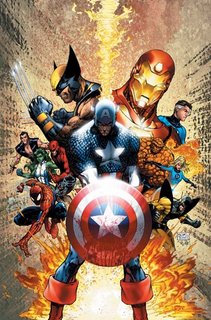For the birth of The Boy, I decided it'd be neat to grab a few current comic books and toss them into the mix. Well, my timing couldn't have been better, for he was born near the beginning of the Marvel Civil War.
 It's an excellent concept. Imagine a COPS-type show, but with third tier superheroes as the cops. Then imagine they stumble across some real big bads. They know they're outclassed, but in a quest for ratings, they try to take them. The result? Stamford, Connecticut blown up, killing most of the heroes and about 60 kids. The public goes nuts. Congress rapidly passes a law requiring Superheroes to 1) reveal their secret identities to the feds, 2) be trained and registered as law enforcement agents, and 3) be put on the Federal payroll (and presumably at their beck and call). The superhero world splits down the middle, with IronMan on the side of the Feds, and Captain America refusing to register and going underground a the leader of the restance. (Listen to the NPR story from May, here. They've got the first 7 pages as a pdf, too.).
It's an excellent concept. Imagine a COPS-type show, but with third tier superheroes as the cops. Then imagine they stumble across some real big bads. They know they're outclassed, but in a quest for ratings, they try to take them. The result? Stamford, Connecticut blown up, killing most of the heroes and about 60 kids. The public goes nuts. Congress rapidly passes a law requiring Superheroes to 1) reveal their secret identities to the feds, 2) be trained and registered as law enforcement agents, and 3) be put on the Federal payroll (and presumably at their beck and call). The superhero world splits down the middle, with IronMan on the side of the Feds, and Captain America refusing to register and going underground a the leader of the restance. (Listen to the NPR story from May, here. They've got the first 7 pages as a pdf, too.).Killer stuff, here. Blazingly political, and fascinating even if, like me, you don't know who in the hell half of these guys in the tights are. They're up to Ish 3, and so far it's great! We're getting a nice range of responses to the registration demands, ranging from mindless to thoughtful to those nearly torn in two by the decision. It looks like some of the crew will be switching sides as time goes on, and I'm eating it up.
The main storyline is only 7 issues, but when you roll in all the tie ins, the official total is 85. Add in the oblique references, and it's gotta break 100, easy. I'm going to be watching Spidey and The Thing. I figure maybe a dozen or so issues, total. I've never read superhero comics before, but these are great! Oh, and looking around the web, I see that Joss Whedon had a hand in plotting the final installment. Now you know it kicks butt! If there's one person in this world whose creative impulse can be trusted, it's Joss's.


1 comment:
Speaking of comic books, there is a graphic adaptation of the 9/11 Commission Report done by a couple of comic book illustrators (Sid Jacobson, Ernie Colon). Here's a review courtesy of Barnes&Noble.com:
A comic book, utterly serious, documenting the attacks of September 11. The horrendous events of that day may seem an odd choice for comic-panel treatment, but Jacobson and Col-n-known to legions of fans for their longtime work at DC and Marvel Comics-are doing an honorable public service by putting the official report in a form that anyone can understand, through words or not. The project is fraught with peril; as drawn, for instance, Ronald Reagan looks more like Leonid Brezhnev than the Gipper, and it must have been daunting to reduce the carefully nonpartisan complexities of the report to a few frames depicting, say, Condoleezza Rice's failure to grasp the meaning of actions on which she had been fully briefed, to say nothing of the president's inaction. For all that, the captions pack a lot of punch. Reads one, "Little effort in the legislative branch was made to consider an integrated policy toward terrorism. All committees found themselves swamped in the minutiae of the budget process, with little time for the consideration of longer-term questions." The point is well-taken, even as Osama bin Laden's eyes glower from the page. The graphics are meaningful as well, and some of them, such as the depiction of Afghan leader Ahmed Shah Massoud's last moments, are, well, quite graphic. The book includes the 9/11 Commission's sober determination that the invasion of Iraq was based on anecdotal evidence at best, as well as its recommendations that since so much of the US infrastructure is in private hands, the government would do well to integrate civilians into emergency planning. The most telling moment here comes at the end, and here the graphic treatment is exactly right: It depicts the Commission's "report card" on the administration's response to its findings, with an average grade of D. All told, a thoughtful-and by no means dumbed-down-approach to events still very current.
Post a Comment